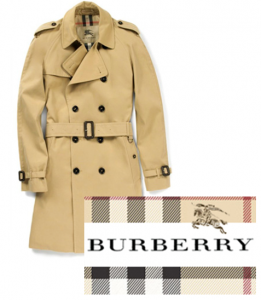 Burberry has made extensive social media efforts this year to tell the public how its iconic look and status developed over time. Companies, like Burberry, with a visual history to promote, are especially attracted to Facebook’s Timeline.
Burberry has made extensive social media efforts this year to tell the public how its iconic look and status developed over time. Companies, like Burberry, with a visual history to promote, are especially attracted to Facebook’s Timeline.
Timeline lets users post stories and pictures in chronological order. Visitors scroll down on a Facebook page and go back in time to the initial creation of a product.
The company can create a nostalgic connection between the visitor and the brand. The Facebook Timeline for this “156 year-old global brand with a distinctly British attitude” includes photos of Burberry’s first store opening in 1856, images of pilots wearing Burberry aviator suits, and pictures of its classic trench coat through the years.
Then Burberry posted a photo of Humphrey Bogart (Rick) wearing an actual Burberry trench coat in that sublime final scene of the film Casablanca, where Rick stands on the foggy runway, one of “three little people” whose problems “don’t amount to a hill of beans in this crazy world…” The Burberry caption underneath the photo reads: “Humphrey Bogart wearing a trench coat in the final scene of Casablanca (1942).”
In late spring 2012, Bogart LLC, the entity which controls Bogart’s publicity rights and the trademarks associated with his name, contacted Burberry and ordered the company to cease using the photo at once. Bogart LLC claimed the use of the photo violated Humphrey Bogart’s publicity rights and constituted trademark infringement. Burberry’s use of the photo, it claimed, implied an endorsement by or an affiliation between Humphrey Bogart and the brand. Burberry’s response was not to take the photo down but rather to take the proactive step of filing for declaratory judgment of non-infringement. Burberry is asking the court to determine that its use of the image in its historic timeline was not unfair misappropriation or a violation of Bogart’s rights, but is permitted expression under the First Amendment.[1] In its declaratory action complaint, Burberry argues that the use of the photo in no way implies personal endorsement or any commercial connection to Bogart, but rather is an historical use of the image for the purpose of educating the public about Burberry apparel over the last century. The latest complaint, filed by Michael Allen at Steptoe & Johnson, can be read here.
Bogart LLC is no stranger to vigilant protection of its publicity rights. You may recall Bogart LLC suing the makers of a sofa that shared Bogart’s name two years ago. That case has yet to be settled.
This current case raises a new occasion for exploring criteria for the application of the Fair Use doctrine in the trademark arena: What distinguishes commercial and editorial use for Fair Use purposes? It was the Ninth Circuit in New Kids on the Block v. News America Publishing, Inc. that recognized a “nominative fair use” defense for a publisher that uses another’s trademark to make a point that can’t be stated without that trademark, so long as the publisher uses no more of the trademark than necessary and does not imply sponsorship. Burberry’s argument for a fair use defense to the trademark infringement claim is relatively strong since the use purports to be showing an historic fact, this very use of the Burberry trench coat by the celebrity shown, in the context of a depiction of its more extended history.
Under the circumstances, shouldn’t anyone be free to report this fact in film history? And shouldn’t a company be free to comment on its own history with illustrations of it? Maybe, but a report by a disinterested third party about a Burberry coat showing up in a film is different from Burberry making the same point in what one could argue is inevitably, however styled, a promotion of its goods. Of course, the analysis would be markedly different if the photo and name were part of an ad campaign for a new line of “Bogart” coats.
Trademark rights and “publicity rights” exist in a balance with First Amendment freedoms. Factors are weighed in each case presented, and where the line is to be drawn is never clear cut. The Bogart party sees a “slippery slope” in Burberry’s use. As Stephen Bogart, son of the late actor, said in a news release: “What’s next, a cigarette company can start an advertising program claiming Bogie smoked its brand, and there’s nothing our family can do about it?” Bogart, who was famous for his smoking habit, died of throat cancer in 1957.
In this case, the apparel company moved to file its complaint first and chose the New York jurisdiction before the Bogart claimants could pick a different locale. Because Bogart is dead, so are his publicity rights under New York law. In other states, California for example, publicity rights survive post mortem. Thus, this case, filed in New York by Burberry to get a ruling, becomes an action focused more on trademark rights and endorsement issues than on the personal publicity rights that might predominate in a California action.
Actions that address the implications of internet communications are often complicated by the choices that jurisdictional differences offer. In the rights of publicity realm, there are twelve states (California among them) that characterize publicity rights as a property right that survives a celebrity’s death. In other states, like New York, publicity rights are characterized as personal rights that die when a celebrity dies. Usually, the rights holder’s domicile at the time of death determines which law applies. California, however, recognizes post-mortem rights of publicity regardless of domicile at death in its Dead Celebrities Act, signed by Governor Arnold Schwarzenegger in 2007. This feature of the California law was added after courts in both California and New York determined that Marilyn Monroe’s domicile was New York, thereby terminating her post-mortem publicity rights.
Some right of publicity statutes cover only the use of a person’s name and likeness. Other states recognize a broader personal property right in a person’s voice, appearance, gestures, distinctive characteristics, name, signature, and photo. Some of the laws are vaguer than others; certainly the application varies markedly state-by-state. The result may be that publishers, advertisers and content developers have difficulties determining exactly what conduct will expose them to liability. There are proposals that the wide variation in state publicity laws be addressed by a uniform federal right of publicity law, especially since publication usually does not observe state boundaries, and the free expression defenses raised are usually federal in origin. Still such vast differences between states don’t readily lend themselves to the adoption of a uniform standard.
[1] Because Burberry had secured a license to use the photo itself (though not the Bogart image), copyright law is not at issue here.

